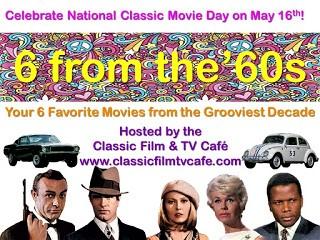
It's May 16, National Classic Movie Day, and Rick over at the Classic Film & TV Cafe is hosting his annual blogathon to celebrate the occasion. This year the subject is 6 from the '60s, in which each participating blogger puts the spotlight on six films of that decade. Click here to find out more and for links to all participating blogs.
~
In the preface to his detailed tour of the decade, The Fifties, Pulitzer Prize winning reporter/author David Halberstam begins with "The fifties were captured in black and white...by contrast, the decade that followed was, more often than not, caught in living color." Even so, most of the '60s movies featured here were shot in black and white, but by the time the decade ended very few films were being made that weren't in color. In fact, the final film on my '60s list, Rosemary's Baby, from 1968, makes brilliant use of its color palette. But first...
1. The Apartment (1960), directed by Billy Wilder, written by Wilder and Izzy Diamond, starring Jack Lemmon, Shirley MacLaine and Fred MacMurray. This is one of Billy's very best and the film of his most honored by the Academy. Nominated for 10 Oscars, it won five: Best Picture, Best Director, Best Screenplay, Best Art Direction and Best Editing. The film's other nominations were for Lemmon and MacLaine's lead performances, Jack Kruschen's supporting role, and for cinematography and sound.
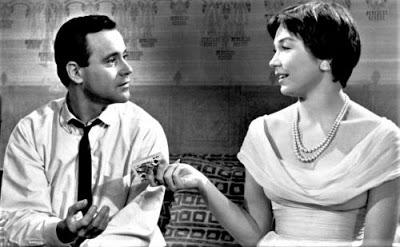
Jack Lemmon and Shirley MacLaine as C.C. Baxter and Fran Kubilek
Contemporary director Cameron Crowe has called The Apartment a "potent martini of a movie." Yes, and a martini with more flavor than most, from its then-racy subject of infidelity and hanky-panky in the corporate workplace to its sharp and witty script, the dazzling performances of Lemmon and MacLaine, its superb production design (Alexandre Trauner) and musical theme (Charles Williams). This is the film that launched Jack Lemmon as an enduring lead actor, made Shirley MacLaine a star, and proved - as Wilder's Double Indemnity (1944) had already plainly illustrated - that Fred MacMurray's range as an actor was much broader than most recognize. MacLaine deserved the "actress in a leading role" Oscar for 1960, but the Academy happened to be voting just at the moment Elizabeth Taylor barely survived life-saving emergency surgery on her windpipe. Taylor, whose death was prematurely - if only momentarily - reported worldwide, would ultimately take Best Actress for her performance in the third-rate melodrama, Butterfield 8. MacLaine later joked, "I lost to a tracheotomy."
2. Breakfast at Tiffany's (1961), directed by Blake Edwards, screenplay by George Axelrod based on Truman Capote's novella, starring Audrey Hepburn, with George Peppard, Patricia Neal, Martin Balsam and Mickey Rooney. Academy Awards for score and song ("Moon River"), nominations for Best Actress, art direction and screenplay.
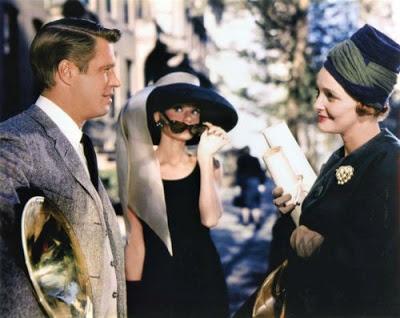
George Peppard, Audrey Hepburn and Patricia Neal
Set in vibrant Manhattan during the late '50s/early '60s, the film features effervescent Audrey Hepburn gowned impeccably and enviably by Hubert de Givenchy, her hair swept up into a never-to-be-surpassed updo called the "beehive," bedecked in jewels, hats and shoes to die for. The story is based on a short Truman Capote piece about a nomadic young woman, Holly Golightly, stylishly afloat in the big city's fast lane. Neither a prostitute nor a call girl, she is a rudderless beauty, a sometime model, who has fallen into the life of what was once known as a "party girl." These ladies did not exactly have a set price tag, but there was the unspoken understanding that if the escort of an evening provided the requisite dinner, drinks, entertainment and a reasonable amount of "powder room" cash, he would likely spend the night with her. This is Holly's "madcap" lifestyle when a young writer (Peppard) moves into her building and a relationship begins to develop between them. The romcom of the 1960s.
3. Cleo from 5 to 7 (1962), directed and written by Agnes Varda, starring Corrine Marchand. French with English subtitles. Varda was nominated for the 1962 Palme d'Or at Cannes for this film.
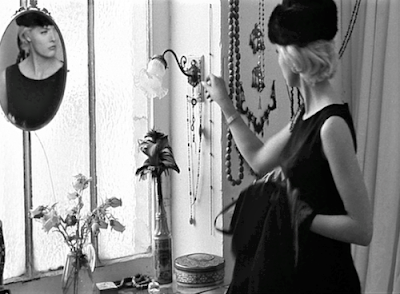
Corrine Marchand
Marchand portrays Cleo, a popular French pop singer who hasn't been well and will soon - today - get the results of a biopsy that will either provide great relief or deliver very bad news. As she awaits her diagnosis, the camera follows her in near-real time - from 5 to 7 - as she wanders the iconic Parisian streetscape of the early 1960s. This French New Wave groundbreaker was shot entirely on location in Paris and features a score by Michel Legrand (The Umbrellas of Cherbourg). The film also features José Luis de Vilallonga as Cleo's lover. Villalonga, some will remember, portrayed Holly's Brazilian lover in Breakfast at Tiffany's.
3. The Man Who Shot Liberty Valance (1962), directed by John Ford, screenplay by James Warner Bellah and Willis Goldbeck, starring John Wayne, James Stewart, Vera Miles and Lee Marvin. One Oscar nomination, for Edith Head's costume design.
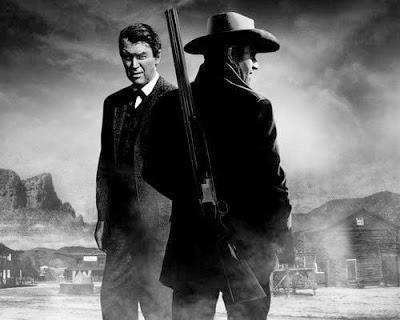
James Stewart and John Wayne
"This is the West...When the legend becomes fact, print the legend." That famously oft-quoted line comes at the end of Liberty Valance underscoring how, as the Old West died and the new was born, fiction would become fact.
James Stewart portrays a U.S. senator returning to the west, the town of Shinbone where his reputation was made many years earlier, for a funeral. The senator and his wife (Miles) are greeted with much ado, but the town folk just can't understand why they've come to attend the funeral of a man (Wayne) no one knows. The reason unfolds in Stewart's long flashback and it turns out to be a bittersweet, legend-busting tale.
Liberty Valance would be the last of the Ford/Wayne Western classics, and a masterful final entry it is.
4. A Hard Day's Night (1964), directed by Richard Lester, written by Alun Owen and starring The Beatles. Oscar nominations for screenplay and music.
Anyone who was ever a Beatlemaniac, not to mention the many millions who arrived in the world and became fans later on, will understand why I picked A Hard Day's Night. The band was still new to the U.S. and in the first blush of international uber-fame when the film was released in the summer of 1964. This music-packed, cinema verite-style romp gave the world a fictional - and very funny - glimpse into a day (plus) in the life of the biggest rock stars whoever lived. It was a joy then and still is. Here's the trailer, with 💓 John singing lead on the title song 💓...
6. Rosemary's Baby (1968), directed by Roman Polanski who also adapted Ira Levin's bestselling novel for the screen, starring Mia Farrow, John Cassavetes and Ruth Gordon. Oscar win for supporting actress (Gordon) and a nomination for Polanski's screenplay.
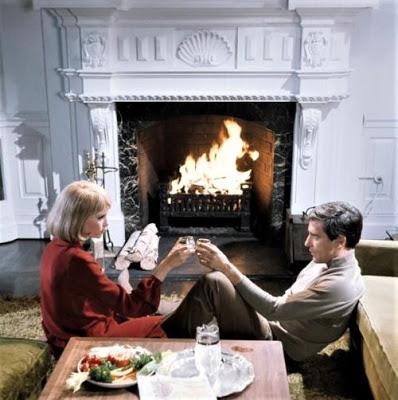
Mia Farrow and John Cassavetes
I once read that Roman Polanski had seen Hitchcock's Psycho (1960) several times in the days following its release. What he learned from the older master's most horrific work is evident in Polanski's first American film. But I also believe Polanski, like Hitchcock, has a natural genius for visual storytelling. When Rosemary's Baby came out I saw it several times early on. I was fascinated by how I'd been so thoroughly drawn into this yarn about witchcraft on Manhattan's Upper West Side, how my own point of view seemed to coincide so exactly with Rosemary's as her life became increasingly frightening. Years later I would learn that Polanski had made much use of point of view shots and imaginative framing to ensure viewers would see just what Rosemary saw and identify with her deepening fear, anxiety and paranoia.
Rosemary's Baby, a tale of marriage and pregnancy gone wickedly off the rails, was a box office smash that opened the gate for the every big-budget horror film to come - The Exorcist, The Omen and all the rest.
~
Click here to read the rest of the entries in this year's National Classic Movie Day at The Classic Movie & TV Cafe. All good stuff!
